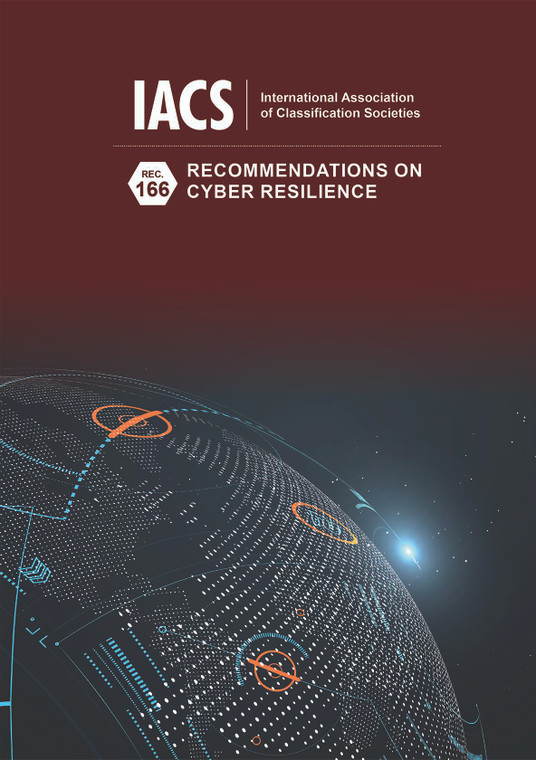
This publication outlines the technical requirements needed to produce cyber resilient ships. It consolidates IACS’ previous 12 recommendations on cyber resilience.
These recommendations outline the technical requirements needed to ensure that ships are cyber resilient and have the capability to cope with cyber incidents that may occur on board.
They provide guidance on risk mitigation and are designed to ensure that the design, integration and/or maintenance of computer based systems support secure operations and protect against unauthorised access. Topics covered include:
- Reference guidelines and standards
- terms and definitions
- goals for design and construction
- functional and technical requirements
- verification testing.
These recommendations support IMO Resolution MSC.428(98) ‘Maritime Cyber Risk Management in Safety Management Systems’.
The purpose of this Recommendation is to provide technical requirements for stakeholders that lead to the delivery of cyber resilient ships, whose resilience can be maintained throughout service life.
Resilience,
in
this
context,
is
meant
as
a
characteristic
that
provides
crew
and
ships
with
the
capability
to
effectively
cope
with
cyber
incidents
occurring
on
computer
based
systems
on
board,
which
contribute
to
the
operation
and
maintenance
of
the
ship
in
a
safe
condition.
The
most
effective
method
of
dealing
with
an
incident
is
to
prevent
it
ever
happening.
Therefore,
in
this
context
‘prevention’
is
more
important
than
‘cure’.
It
is
intended
that
recommendations
herein
provide
guidance
for
mitigating
the
risk
related
to
events
affecting
onboard
computer
based
systems,
recognising
that,
if
no
measures
are
implemented,
such
events
could
potentially
affect
human
safety,
the
safety
of
the
ship
and/or
present
a
threat
to
the
marine
environment.
The
intent
of
this
Recommendation
is
to
ensure
that
design,
integration
and/or
maintenance
of
computer
based
systems
supports
secure
operations
and
provide
a
means
to
protect
against
unauthorised
access,
misuse,
modification,
destruction
or
improper
disclosure
of
the
information
generated,
archived
or
used
in
onboard
computer
based
systems
or
transported
in
the
networks
connecting
such
systems.
This
Recommendation
seeks
to
support
IMO
Resolution
MSC.428(98)
(June
2017):
‘Maritime
Cyber
Risk
Management
in
Safety
Management
Systems’,
which
requires
cyber
risks
to
be
addressed
in
safety
management
systems
by
1
January
2021,
based
on
MSC-FAL.1/Circ.3
(June
2017):
‘Guidelines
on
Maritime
Cyber
Risk
Management.
Chapter 1: Introduction
Chapter 2: Scope
Chapter 3: Reference Guidelines and Standards
Chapter 4: Terms and Definitions
Chapter 5: Goals for Design and Construction
Chapter
6:
Functional
Requirements
Chapter 7: Technical Requirements
Chapter 8: Verification Testing
Appendices:
Appendix
A:
Detailed
List
of
Standards
Appendix
B:
Documents
Referred
to
in
Recommendation
Appendix
C:
Mapping
of
Sub
Goals
to
Technical
&
Verification
Requirements
Annex
A:
Guidance
on
Operational
Aspects
Addressed
in
Recommendations
Reference List
IACS
Dedicated to safe ships and clean seas, IACS makes a unique contribution to maritime safety and regulation through technical support, compliance verification and research and development. More than 90% of the world's cargo carrying tonnage is covered by the classification design, construction and through-life compliance rules and standards set by the twelve Member Societies of IACS.
IACS is a not for profit membership organisation of classification societies that establish minimum technical standards and requirements that address maritime safety and environmental protection and ensures their consistent application. It carries out this responsibility through its panels, expert groups and project teams and provides a Quality System Certification Scheme (QSCS) that its Members comply with, as an assurance of professional integrity and maintenance of high professional standards. IACS is recognized as the principal technical advisor of IMO.
- Number of Pages:
- 86
- ISBN:
- 9781856099424
- Binding Format:
- Paperback
- Book Height:
- 297 mm
- Book Width:
- 210 mm
- Weight:
- 0.7 kg
- Author:
IACS
- Published Date:
- August 2020
- Preview:
- Yes
- Publication Date:
- August 2020



